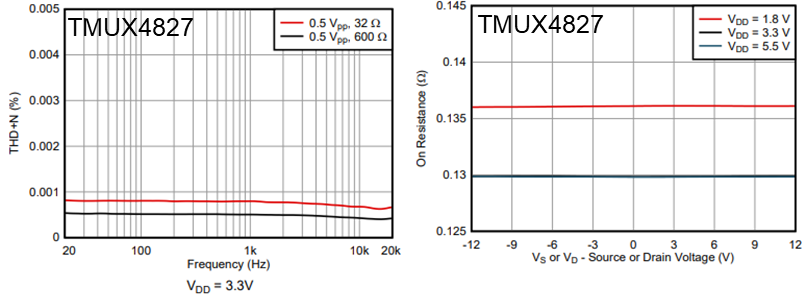SCDA058 September 2025 TMUX1575 , TMUX4827 , TMUX7612 , TS5A22362 , TS5A22364
4.1 Understanding THD(+N) of a Multiplexer
For multiplexed systems, the observed THD(+N) performance is a function of the On-Resistance (RON), RON flatness (variation of the mux channel RON across the applied signal range) of the device and the load resistance, RL. As the ratio RL/RON increases the THD+N performance improves. This is due to the creation of an amplitude-dependent voltage divider, as shown in Figure 4-2, through the combination of Ron and RL. This follows then that the observed harmonic distortion of the mux output is minimized when RL is larger, such as a high impedance input of a non-inverting amplifier.
 Figure 4-2 Voltage Divider Created by MUX RON and RL
Figure 4-2 Voltage Divider Created by MUX RON and RLTypically, for applications where THD matters, the operational peak-to-peak voltage range can be a smaller range than the full voltage swing the mux is capable of. Therefore, this is important to verify that the operating voltage of a device does not fall in a region where the RON of the mux varies greatly. Some Ron curves are flat across the entire region, while others can have optimized performance across a specific input voltage region. Figure 4-3 shows how the same device can have different THD performance, given different operational peak-to-peak (Vpp) voltages.
 Figure 4-3 RON Curve With Optimized (Green) Vpp Region vs Unoptimized (Red) Vpp Region
Figure 4-3 RON Curve With Optimized (Green) Vpp Region vs Unoptimized (Red) Vpp RegionTo optimize THD performance, the recommendation is to use the RON region of the multiplexer that is the flattest. Figure 4-4, shows the optimized THD Regions for common of RON curves for analog multiplexers. Figure 4-5 highlights how an ultra-flat RON optimizes THD performance in the TMUX4827.
 Figure 4-4 Best Region (Green) of VIN for Optimized THD Performance
Figure 4-4 Best Region (Green) of VIN for Optimized THD Performance  Figure 4-5 TMUX4827 Achieves Optimized THD Performance Through Ultra-Flat RON
Figure 4-5 TMUX4827 Achieves Optimized THD Performance Through Ultra-Flat RON